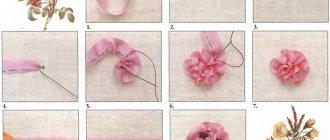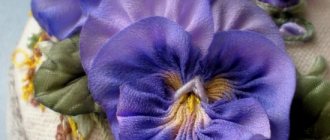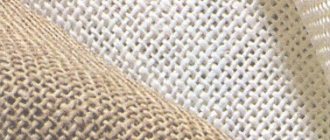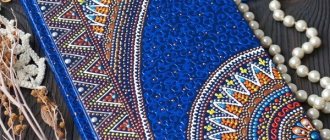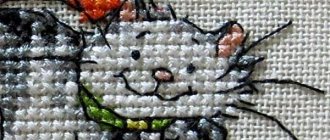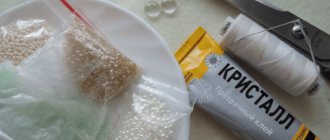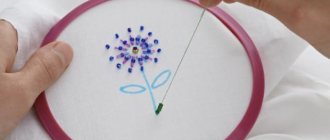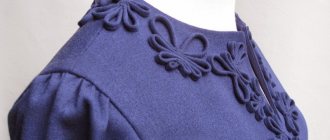Selection of fabric for the base of embroidery
Beginners are recommended to carry out their first works on Aida canvas No. 14. This material is rigid and holds its shape well. Simple ribbon compositions on such a canvas can be embroidered without a hoop. As your skill improves and your stitches become more accurate, you can use other fabrics.
The table below shows the names of fabrics suitable for ribbon embroidery:
| Cotton | Linen | Silk | Woolen |
| Gozhka | Harsh canvas | Chiffon | Crepe |
| Satin | Thin fabric | Silk tulle | Tweed |
| Muslin | Scrim | Chesucha | Jersey |
| Velvet | Linen uniform fabric | ||
| Batiste |
It is important that the color of the fabric or canvas matches the intended ribbon pattern.
When choosing a canvas, you need to pay attention to its density. If the material is too thin, it will show through and the reverse side of the embroidery with knots and hidden stitches will be visible.
To embroider on thick fabrics (drape, velvet, printed fabric), you will need an awl, which is used to make holes for the needle and ribbon in advance. If you do not pierce the fabric, the needle will enter very difficult. And the tape can stretch or become deformed.
Embroidering different flowers and bouquets using ribbons
Lilac ribbons
SMALL FLOWERS
Cornflower can be beautifully combined with yellow spikelets.
The flower itself is embroidered with a strip of 5 millimeters. She is brought to the front side. Place the petal. They grab it with a thread. The satin is brought out on the wrong side below. Next, the petals are made according to the same pattern. And the flower is ready. The spikelets are embroidered with a simple basic straight stem. Small flowers with ribbons
HOW TO EMBROIDERY PANSIES WITH Ribbons
Embroidering ribbons in several layers will help create beautiful pansies. It is recommended to use satin strips of medium width. An air loop is used for embroidery. First, the bottom layer is formed. It can consist of 5-6 loops. Then make smaller loops of the top layer. The grass can be embroidered with a regular stem from a thin strip.
Pansies
Forget-me-not buds (FRENCH KNOT)
It is recommended to embroider forget-me-not buds using a French seam. To do this, pull the tape onto the front side of the canvas. Leave a one centimeter tip on the wrong side. Stretch the strip and throw it over the needle at a height of 1 cm from the fabric. Twist the needle while continuing to tighten. Make 2 turns. The tip of the needle is injected 1 mm from the insertion site. Bring it inside out and pull out the satin.
French knot
BEAUTIFUL PEONY WITH Ribbons
In MK embroidery of peony with satin, ribbons of different widths are used. You need to cut the satin 7 centimeters long across the width of your palm. Form petals. Form 2 antennae on a narrow ribbon. Round off the ends. Make notches. Then make air stitches with a middle stripe. Then make another level with a wide ribbon and finish with a core. The rose is embroidered in the same way.
Peony scheme
EMBROIDERED TULIPS IN A BASKET
The master class on creating tulips contains instructions for creating the flowers themselves and the sequence of creating the petals. The satin is pulled to the front side, then 5 centimeters are retreated from the edge. A hole is pierced and the satin is pulled through. The straight stitch should not lie too tightly on the base. This is how the bud comes out. It can be formed with two volumetric stitches.
Ribbon tulips
HOW TO INSERT THE RIBBON INTO THE NEEDLE
A bell or other flower must be formed correctly. To do this, follow the rules for securing the satin in the needle and fabric. The satin is slightly burned. Insert into a needle. Then the needle is inserted from the edge of the strip 1 centimeter down the center. It turns out to be a sailboat. Pull the end of the cauterized strip. Tie a knot.
You might be interested in: How to properly wash cross stitch on canvas
How to insert tape
ROSE SPRANCH FROM SATIN RIBBON
The ribbon to create a rose is first twisted and the core is formed in the shape of a bud.
Next, take another piece of the required length. Thread a needle and wrap it around the bud, making stitches. The rest of the flowers are created using this principle. Then they begin to form the stem and leaves. Rose branch
LILY OF THE LILY WITH SATIN RIBBON
Meadow lily of the valley is made from a narrow ribbon. Make a twisted loop. Bring the tape to the front side closer to the top of the loop. Unfold the petal using a stitch. Insert a pin into the loop at an angle from bottom right to top left. Make a curl by pulling it up. Fasten with a small stitch of white thread and another needle. Take out the pin.
Ready-made lilies of the valley
FUCHSIA FLOWERS
Poppy and fuchsia are some of the most popular flowers embroidered with ribbons. For fuchsia, use pink ribbons. Form a fuchsia skirt. Place 2 straight stitches. The stamens are made with embroidery thread. A few more straight stitches of shorter length are embroidered on top of the lower petals. Next, buds are formed in a darker tone.
Scheme of fuchsia flowers
EMBROIDERY WITH DAMOMILES Ribbons
There are many options for embroidering flowers with ribbons. You can also find daisies. This is an option for beginners. The needle is threaded with ribbon. They straighten it out. Make a stitch and bring the needle down. Make the loop a little airy. Bring the needle out next to the intended next petal. They make another stitch. All other chamomile petals do the same.
Scheme for daisies
BLOWING JAPANESE CHERRY
A master class on delicate cherry blossom embroidery will help you create a spring picture. The flowers are formed with simple straight air stitches. You can take white ribbons and then tint them a little. It is not necessary to embroider branches with satin. They can be made with threads.
Japanese sakura
Ribbon embroidery is an easy way to create a three-dimensional picture. It is enough to know a few basic stitches. They can be used to create lush peonies and delicate miniature lilies of the valley. It is recommended to choose canvas as a fabric base at the initial stage of training. And then switch to thick linen.
Source
Selection of tapes
Satin, silk and nylon ribbons are suitable for embroidery. These are synthetic materials that do not fade when washing finished work and can withstand heat treatment (ironing, steaming).
The width of ribbons suitable for embroidery varies from 2.5 to 16 mm. They drape well and are easily pulled through the fabric. Narrow ribbons are used for regular stitches, and wide ones for creating voluminous petals and leaves.
The most popular ribbons for embroidery are satin
Satin ribbons differ from others in that the texture of the front and back sides has a different weave. Sometimes you come across hard ribbons that can also be used for embroidery. Before starting work, you need to cut the ribbon to the required length from the skein and stretch it with crayfish.
Silk ribbons are used to create designs with fine details or complex stitches. Their texture is the same on both sides. The material from which such tapes are made is soft and elastic.
Nylon ribbons are needed to give embroidery a special texture. They are stiffer than satin and silk, and also thinner. There are transparent veil ribbons that are used to decorate individual sections of embroidery. They can have a metallized insert on the edge or in the middle, as well as a printed pattern.
Fire red rooster
Required equipment:
- satin ribbons of different colors;
- sackcloth;
- floss thread;
- comfortable hoop;
- needles and scissors;
- tracing paper and pencil.
It is necessary to find the center of work. To determine the center of the burlap, it is folded in half and then in half again. Along the fold lines, the fabrics are separated with a “back needle” seam. When the canvas for work is prepared, it is necessary to redraw the image of the bird on tracing paper. After which the pet is transferred onto the burlap on tracing paper.
Related article: How to make a pony from “Friendship is Magic” from plasticine step by step with video
Having a finished sketch on the canvas, it can be inserted into the hoop, stretching the fabric. The work with ribbons begins with the embroidery of the largest details; in this exhibition, these are the breast and neck of the bird. It’s easier to start with four stitches on the neck of the rooster with a gold-colored satin ribbon. The thread length of each line is about 15 mm. After that, four more similar lines are made on the chest. But their length is shorter and equal to 10 mm.
According to the diagram outlined above, the entire body of the pet is filled in turn. The stitch angle for the bottom part should be changed. To give volume to the embroidery, some stitches are duplicated. More often, a double layer is used on the neck and chest, in our case it is a yellow satin ribbon. When embroidering the second layer, the stitches are placed in the required direction. Straight ribbon stitches are used to fill out the pet's lower torso. For work, satin ribbons of blue and deep blue colors are used. The cockerel's wing is embroidered with ribbons of the following colors: blue, yellow, deep blue. The bird's head and beak will be golden yellow.
In order to achieve a natural beak, straight ribbon stitches are passed along it. The cockerel's head is also embroidered using curved stitches. In this case, the shortest stitch is applied first, and then subsequent lines are made. In conclusion, it turns out that each subsequent stitch slightly overlaps the previous one. The beard and comb are “drawn” with a scarlet ribbon using a straight stitch. French knots are embroidered in place of the eyes.
Curved stitches are used for the cockerel's tail. To create it, various shades of blue are used. A twisted stem stitch is used to create the long claws and paws of poultry. Short claws are highlighted with straight twisted stitches. When embroidering flower stems, a “back needle” stitch is used.
Straight stitches are also used when embroidering petals, and French knots are used for the core. To embroider grass, regular stitches of different lengths are sufficient.
Article on the topic: Cotton - composition, properties, use and care of the material
The embroidery is ready, you can seal it, insert the embroidery into a frame and hang it on the wall or give it to someone as a gift!
It is also possible to embroider a formidable warrior rooster, as in the photo.
Markers
To carefully transfer the outline of the drawing onto the canvas, you can use simple pencils of hardness B, B2 or B3. For other fabrics it is better to use special water-soluble markers.
They can be purchased at craft stores. The design is transferred to the fabric, embroidered according to the markings, and when the product is completely ready, it is washed in cold water and all drawn lines are completely removed from the fabric.
Framework
Special frames are purchased to tension the fabric on which embroidery will be done. The device that holds the fabric is called a hoop. They can be round or square. When purchasing such frames, it is better to give preference to wooden products.
It is important to inspect and check the quality of the paint, and also make sure there are no defects (small chips and burrs). Poor quality painting can ruin the work, leaving stains on the canvas, and small flaws in the frame often damage the fabric and tapes.
Which needles are suitable for the job?
Simple needles are not suitable for ribbon embroidery. The eye of the needle should be wide and long, and the tip thin but rounded so that it can easily pass between the weave of the fabric without tearing it.
For ribbon embroidery, you should choose needles with a wide eye.
Most often, ribbon embroidery masters use needles with the following numbers:
- № 14.
- № 18.
- № 20.
- № 22.
- № 24.
- № 26.
The higher the number, the narrower and thinner the ear. It is important that the tape does not wrinkle in the needle, but also does not fall out. For example, a size 18 needle is suitable for 7mm wide ribbons.
Simple patterns
To create a picture with flowers from satin ribbons you need:
- canvas for arranging the composition;
- several needles;
- lilac thread;
- satin ribbon in green, yellow, purple and lilac;
- comfortable hoop;
- graphite.
The design of the selected flower must be transferred to the canvas blank. The first time it is better to use a simpler drawing. For example:
For craftsmen who have little experience behind them, the image shows the stitches that are used in embroidering a picture with patterns of flowers using threads of satin ribbons. When the drawing is transferred to the canvas, it must be secured in a hoop.
The feelings when embroidering with ribbons should resemble the feelings that prevail when writing text, that is, lightness and ease.
The tape must be secured. The three petals located at the top are embroidered with a straight stitch. It is necessary to pull the needle with the main material to the front side. The length of the petal is controlled by the pattern and during the contact process the needle comes out to the wrong side.
After completing the embroidery of the upper petals, the embroidery of the petals on the sides and bottom continues. Their implementation is similar to the upper petals.
When the flower petals are ready, it is necessary to embroider the core of the plant. This means that it is necessary to use a loop stitch. A seam is made with a needle pointed to the side; you should remain on the wrong side and sew the seam again. The loop is tightened and the needle returns to the wrong side. The petals located at the bottom are decorated with floss thread.
Article on the topic: Openwork crochet top from motifs for beginners with photos and videos
Stem embroidery is done by twisting the stitches. The needle must be on the front area, turning, forming a ribbon. You must remember to secure the seam with a knot.
The leaves are sewn using a ribbon stitch. The tape is straightened and pierced with a needle. After which the tension level of the satin ribbons is adjusted. Actions continue until the composition is completed.
How to insert ribbon into a needle
The ribbon must be properly fixed so that it does not slip out of the needle, and it must also be securely attached to the wrong side of the embroidery. Beginners need to practice on small pieces of tape of different widths.
Step-by-step instruction:
- The edge of the tape must be cut obliquely.
- Using the resulting angle, it is inserted into the eye of the needle.
- Stretch the tape so that the figurative edge stretches 3-4 cm.
- The needle must be inserted into the center of the tape, departing 5 mm from the oblique cut.
- The fingers of your left hand hold the needle, and with your right hand you tighten the free edge of the tape.
This way the tape will be securely fastened and will not jump out during operation.
Ribbon embroidery for beginners - flowers
Let's continue to look at simple examples and focus on one more flower. This is a beautiful spring tulip. Before proceeding to the instruction, prepare the following set of materials and tools:
- for a bud, a ribbon with a width of 25 millimeters;
- for the stem 6 millimeters of green color and the same color, but with a width of 12-25 millimeters;
- chenille needle;
- scissors.
In this example, we will not require a marker. So, we embroider a tulip with ribbons according to the instructions for beginners:
- First we thread the ribbon through the needle, here it should be clarified that the color can be chosen according to your wishes. We push the needle from the bottom of the fabric, leaving a small section at the bottom, two centimeters is enough.
- Straighten the ribbon so that the front part is on top. Make a loop and insert the needle into the fabric. We try not to get to the previous exit of the material, but leave a distance of one or two millimeters. Make sure that the needle does not get into the ribbon from below, you can pull it along with you.
- We choose how tall the bud will be. Without tightening the tape to the end, we thread the needle at the selected height. We pass the needle through the loop, wrap it around the top and insert the needle next to the last exit.
Again, keep a distance of a few millimeters. We straighten the material, forming a bud. Cut the ribbon, leaving a tail. - Now let's start sewing the stem. We insert a ribbon with a width of 6 millimeters into the needle. We bring the needle out immediately under the base of the bud. Carefully twist the material. We decide on the height of the stem and insert the needle at the bottom, in the right place. The tails can be treated with a lighter to prevent them from unwinding; at this stage, the ends of the bud can also be treated.
- All that remains is to make the leaves; we will use a ribbon with a width of 12 millimeters. We insert the material into the needle. Try not to take a long piece; it is better to change the tape several times. The longer it is, the more likely you are to get confused. Sufficiently long up to 0.5 meters.
- We bring out the needle at the bottom of the stem. We place the material slightly at an angle. We decide on the height of the leaf and place the material face up. We pierce it with a needle at the top. We stitch and get a folded sheet. We repeat the work with the second sheet, but direct it in the opposite direction. The leaves in the background will be looking up.
- Making leaves in the foreground. We return to the bottom of the stem and remove the needle. We place the sheet below the previous ones. We bend the top to the side, pierce and stitch. We repeat the work on the opposite side.
- To prevent the leaves from sticking out, grab them in the central part with a regular thread of the appropriate color. Finish the ribbons on the reverse side using heat.
Methods for processing the edge of a canvas in 1 minute
The canvas can be carefully stitched by hand or processed using an overlocker. But there are 3 ways that won’t take more than 1 minute.
Methods for processing canvas:
- Coat with PVA glue.
- Apply clear nail polish.
- Cover with masking tape or tape.
Such methods of processing the edge of the canvas are suitable only for small jobs or for those products that are not planned to be washed. In other cases, it is necessary to stitch the edges.
Master class on 3D embroidery of peonies for beginners
Embroidering with ribbons (for beginners, the stages of work are described step by step later in the article) of a voluminous flower may seem difficult for beginners, but if you follow the instructions, the peony bud will turn out beautiful and lush.
For embroidery you will need:
- Dense (preferably starched) canvas.
- Bud ribbons with widths of 3, 6, 10, 25 and 40 mm.
- Needles of different sizes.
- Lighter.
- Scissors.
- Pencil or marker.
- Hoop.
Procedure:
- Finish the edges of the canvas and stretch it onto the hoop.
- Decide on the location of the flower and draw a circle with a diameter of 1-2 cm. This will be the center of the bud.
- The needle with the thinnest tape is inserted from the inside out, from the center of the circle.
- The circle must be completely filled with elongated loops. Their length should be the same 1-1.5 cm.
- Having secured the thread on the reverse side, you can carefully cut some of the loops in the middle and singe the ends with a lighter. This item is optional.
- Now you need to sheathe the middle with loops in a circle with a wider ribbon.
- A 10 mm wide tape must be cut in the shape of a semicircle (edge) and singed.
- The tape is brought in from the front side and stitched through the fabric, pulling it out again to the front side.
- These actions are repeated in a circle.
- You need to cut petals from 25 mm wide tape. Their edge is shaped into a heart and set on fire.
https://www.youtube.com/watch?v=4cMECufOfMI
- In order for the petals to acquire a curved shape, you need to slightly bend them in the middle towards you and hold them over the fire for a few seconds.
- Now you need to carefully sew the petals to the bottom of the flower, passing the thread through the fabric. It is important that the leaves bend towards the center of the flower.
- Several large petals are cut from a 40 mm tape, making their edges 3-toothed. Then they are singed and given an oblong shape.
- Just like the last petals, large ones are sewn to the bottom of the flower with threads, but the bend of the petals should be directed from the center of the bud.
- The knots are tightened on the wrong side and the long ends are cut off. All that remains is to burn the cuts.
It turns out a lush bud from the ribbon. The color of the satin can be monochrome and smoothly transition from light to dark. Some craftsmen embroider peonies from white ribbons, and then tint the flower using a brush and batik paint.
Flowers instructions
The most remarkable and at the same time simplest option for how to embroider flowers with ribbons for beginners is do-it-yourself daisies made from satin ribbon. This is why they are so popular among beginners. You need to master a straight seam, with its help we get petals in a circle. It is important to leave the middle unsewn, so that later you can complement it with yellow threads, beads or seed beads. More experienced craftswomen, for whom this has already been a mastered activity, can decorate the middle with yellow French knots. For those who don’t know, knots are made in the following way: we place them on a needle several times and pull them through the resulting curls along the entire length. At the end we get neat knots.
Therefore, it is very important to pay attention to the color of the fabric, because a white daisy on a white background will look, at least, stupid. Give your preference to a dark blue or even black base color. You can find any ready-made examples and lessons on specialized websites, where each step and training in master classes or video lessons are described in detail.
Primary requirements:
- need to master PS and French knot
- contrasting fabric color
- first the petals, then decorate the middle
We fix the fabric in a hoop and embroider flowers and compositions on contrasting fabric with ribbons. We move the petals around the circle, use PS.
Embroidery summer chamomile wreath.
Ribbon tulips
The color of tulips can be very diverse; here the author must use his imagination to get a mosaic of incredible patterns. Complete your work with unblown flowers, that is, with closed green buds, they are made with one PS. The same thing, if they want to depict a half-opened one, use two straight fan-shaped stitches.
Tulips step by step description:
- For buds, therefore, you need to take a width of no more than 15 mm.
- The petals are a straight stitch, but it is made from one point at the bottom.
- The distance between the punctures in the lower part can be approximately 3 mm, no more.
simple stitch “loop with attachment”.
Lilies of the valley decorated with beads
One stem can accommodate at most 6 flowers, and each flower is a French knot, which is covered with a ribbon stitch. This is necessary in order to create a convex bud. It is necessary to decorate the white lily of the valley with yellow beads so that it at least vaguely resembles the original. When making lilies of the valley, special attention is paid to the stem; it is made with threads.
[wpmfc_cab_ss]Interior decoration panel “Lilies of the valley”
Lily of the valley pattern.
The symbol of spring is a bell.
Daisies and bells print
A bouquet of gladioli and amazing orchids. Asters or cosmos.
Delicate sweet peas and pansies.
Fairy and snowdrop template.
Flower angel girl.
Flower butterfly.
Embroidered red poppy flowers
Scarlet red color at the base of the flower. It is better to take satin, unlike silk it does not fade in the sun, is cheaper, does not fade and absorbs moisture perfectly. For large poppies, a tape of at least 25 mm in diameter is required. Let's draw a circle on the canvas and sew petals on it. It is more convenient to draw with a black felt-tip pen or use a simple pencil. Before fastening it into a needle, we singe the edges (ends) with a lighter. Then we pull a needle with a ribbon from the wrong side of the fabric (we cut one edge at an angle of 25 degrees, insert it into the eye of the needle, grab it into the bartack) to the front side, the same must be done with a regular thread threaded into a chenille needle No. 24 (you will find it in needle sets), securing it to the side. We take it out, straighten it beautifully, as evenly as possible. Using a regular seam forward, using a needle and thread, we grab 5 cm of ribbon along its edge with a light accordion. You need to make sure that the stitches are not large, otherwise your poppy leaves run the risk of not being neat.
how to learn to embroider schematic scarlet poppies
Glade of red poppies and forbs.
Combined embroidery method
This is an interesting way to combine several types of embroidery. Experienced craftsmen often make paintings with three-dimensional elements embroidered from ribbons. For example, a picture depicting a flower field and a forest is cross-stitched. From above in the field area, the master embroiders flowers from ribbons.
For thread embroidery, select ribbons that match the overall tone, and mark the location of the flowers in small pieces. Embroider in the same way as on an empty canvas. The results are beautiful panels and paintings with three-dimensional patterns.
Ornaments on clothes and jewelry
Ribbon embroidery is used to decorate clothes or make individual accessories. For example, a peony bud, the master class for making which is described above, can be decorated in the form of a brooch. To do this, the flower is embroidered in the usual way.
And then they carefully cut the canvas in a circle, leaving 1-2 cm to fix the flower on the clasp. The cut edges are processed and a suitable fastener is selected where the bud will be attached.
When embroidering clothes, it is important to pay attention to the fabric of the product. It should be dense and have a wide weave. On thin and smooth fabrics, for example, raincoat fabric, the embroidery will turn out stretched and unattractive.
Patterns for embroidering flowers with ribbons
Ribbon embroidery, whether wildflowers, roses or peonies, is stitched according to a pattern. It doesn't look like a cross stitch pattern. There is no need to calculate anything here. The design is transferred with disappearing chalk onto the fabric and then embroidered with satin. This type of embroidery is notable for the fact that you can come up with an image yourself. At the initial stages of training, it is recommended to use ready-made diagrams.
This is what the diagram looks like
Wildflowers and herbs
Wildflowers are mostly small. Therefore, it is recommended to arm yourself with thin tape. These are mainly violets, cornflowers, forget-me-nots and other small plants. The herbs are sewn with a simple straight stitch. You can add satin stitch for combined embroidery. For flowers, use a French seam. The scheme can be changed at will. Useful advice from craftswomen: it is recommended to make each petal a different size.
Wildflowers scheme
Bouquet of phlox
A vase with phlox looks impressive. A colonial knot is used to embroider flowers. The needle is pulled through and placed over the strip. They pick it up from below and unfold it. Then the free end of the tape is thrown over the needle and a turn is made. Hold the knot with your fingers, pull the needle through the turns and bring it out to the wrong side. Pull the satin until the air knot comes out. Grass and leaves are embroidered with a straight knot.
Phlox scheme
How to embroider lilacs from satin ribbons
A beginner can even master lilacs with ribbons. To do this, take a strip of 4 or 6 millimeters. She is brought to the front side. Then they circle the needle. Step back half a millimeter from the tip of the tape and insert the needle into the satin. It turns out to be a nodule on a leg. Pull the material to the wrong side. All other flowers are made in the same way. It is recommended to take ribbon of different shades. And the flowers, which are planned to be made darker.
You might be interested in this Interesting patterns for embroidering pictures using beads with full stitching
Lilac ribbons
Small flowers
Cornflower can be beautifully combined with yellow spikelets. The flower itself is embroidered with a strip of 5 millimeters. She is brought to the front side. Place the petal. They grab it with a thread. The satin is brought out on the wrong side below. Next, the petals are made according to the same pattern. And the flower is ready. The spikelets are embroidered with a simple basic straight stem.
Small flowers with ribbons
How to embroider pansies with ribbons
Embroidering ribbons in several layers will help create beautiful pansies. It is recommended to use satin strips of medium width. An air loop is used for embroidery. First, the bottom layer is formed. It can consist of 5-6 loops. Then make smaller loops of the top layer. The grass can be embroidered with a regular stem from a thin strip.
Pansies
Forget-me-not buds (French knot)
It is recommended to embroider forget-me-not buds using a French seam. To do this, pull the tape onto the front side of the canvas. Leave a one centimeter tip on the wrong side. Stretch the strip and throw it over the needle at a height of 1 cm from the fabric. Twist the needle while continuing to tighten. Make 2 turns. The tip of the needle is injected 1 mm from the insertion site. Bring it inside out and pull out the satin.
French knot
Beautiful peony with ribbons
In MK embroidery of peony with satin, ribbons of different widths are used. You need to cut the satin 7 centimeters long across the width of your palm. Form petals. Form 2 antennae on a narrow ribbon. Round off the ends. Make notches. Then make air stitches with a middle stripe. Then make another level with a wide ribbon and finish with a core. The rose is embroidered in the same way.
Peony scheme
Embroidered tulips in a basket
The master class on creating tulips contains instructions for creating the flowers themselves and the sequence of creating the petals. The satin is pulled to the front side, then 5 centimeters are retreated from the edge. A hole is pierced and the satin is pulled through. The straight stitch should not lie too tightly on the base. This is how the bud comes out. It can be formed with two volumetric stitches.
Ribbon tulips
How to insert ribbon into a needle
A bell or other flower must be formed correctly. To do this, follow the rules for securing the satin in the needle and fabric. The satin is slightly burned. Insert into a needle. Then the needle is inserted from the edge of the strip 1 centimeter down the center. It turns out to be a sailboat. Pull the end of the cauterized strip. Tie a knot.
You might be interested in this: How to sew a beautiful doll from threads and fabrics
How to insert tape
Rose sprig made of satin ribbon
The ribbon to create a rose is first twisted and the core is formed in the shape of a bud. Next, take another piece of the required length. Thread a needle and wrap it around the bud, making stitches. The rest of the flowers are created using this principle. Then they begin to form the stem and leaves.
Rose branch
Lilies of the valley with satin ribbon
Meadow lily of the valley is made from a narrow ribbon. Make a twisted loop. Bring the tape to the front side closer to the top of the loop. Unfold the petal using a stitch. Insert a pin into the loop at an angle from bottom right to top left. Make a curl by pulling it up. Fasten with a small stitch of white thread and another needle. Take out the pin.
Ready-made lilies of the valley
Fuchsia flowers
Poppy and fuchsia are some of the most popular flowers embroidered with ribbons. For fuchsia, use pink ribbons. Form a fuchsia skirt. Place 2 straight stitches. The stamens are made with embroidery thread. A few more straight stitches of shorter length are embroidered on top of the lower petals. Next, buds are formed in a darker tone.
Scheme of fuchsia flowers
Embroidery with ribbons of daisies
There are many options for embroidering flowers with ribbons. You can also find daisies. This is an option for beginners. The needle is threaded with ribbon. They straighten it out. Make a stitch and bring the needle down. Make the loop a little airy. Bring the needle out next to the intended next petal. They make another stitch. All other chamomile petals do the same.
Scheme for daisies
Blooming Japanese cherry blossom
A master class on delicate cherry blossom embroidery will help you create a spring picture. The flowers are formed with simple straight air stitches. You can take white ribbons and then tint them a little. It is not necessary to embroider branches with satin. They can be made with threads.
Japanese sakura
Ribbon embroidery is an easy way to create a three-dimensional picture. It is enough to know a few basic stitches. They can be used to create lush peonies and delicate miniature lilies of the valley. It is recommended to choose canvas as a fabric base at the initial stage of training. And then switch to thick linen.
Schemes and descriptions of embroidery with ribbons
Beginners can practice embroidering simple flowers. Below are step-by-step instructions for the simplest ribbon embroidery options.
To create these flowers you will need:
- Canvas.
- Scissors.
- Lighter.
- Needles.
- Markers.
Ribbon embroidery (diagrams, photo confirmation) involves choosing ribbons and floss threads by color and width, depending on the design.
Sunflower
To embroider a sunflower you will need yellow (12 mm) and green (6 mm and 25 mm) ribbons.
How to embroider:
- On the canvas you need to schematically draw the silhouette of a flower.
- From the center of the bud, the petals are embroidered in a circle with a yellow ribbon using a ribbon stitch.
- The flower stem is made from twisted tape 6 mm wide. The needle and tape are inserted from below. The tape is pulled out. Twist it into a tourniquet and insert the needle under the bud.
- The leaves are embroidered with 25 mm green ribbon using a ribbon stitch.
Ribbon embroidery: diagrams, photos of sunflower embroidery
The middle of the flower can be filled with embroidery from floss threads. To do this, embroider tight French knots closer to the center, and tighten them looser towards the edges.
Butterflies
The easiest way to embroider a butterfly is to depict its flight from the side. You will need 5 mm and 10 mm ribbons, as well as brown floss threads.
Step-by-step production:
- You need to embroider the body of the butterfly with threads using a “forward needle” stitch.
- Then the antennae are embroidered, making French knots at the ends.
- The front wings are embroidered with a narrow ribbon using a “loop with a tack” stitch. You need to make 2 loops, the top one is slightly longer than the bottom one.
- The lower wing is embroidered with a wider ribbon using a ribbon stitch.
If you take ribbons 10mm and 20mm wide, the embroidery will be more voluminous.
Daisies
Embroidering a chamomile is very simple. You will need white tape 5 mm wide and green tape 5 and 10 mm wide.
Step-by-step production:
- The center of the flower is marked on the canvas.
- The petals are embroidered in a circle using a white ribbon using a ribbon stitch.
- The stems are embroidered from a narrow green ribbon using a “needle forward” stitch.
- The leaves need to be embroidered using a ribbon stitch from a wide green ribbon.
The middle of the flower is filled with yellow floss embroidery, filling the void with French knots.
Orchids
To embroider an orchid flower, you will need white ribbons 10 mm and 40 mm, as well as red ribbon 5 mm and yellow ribbon 3 mm.
All embroidery is done using a ribbon stitch:
- First, three petals are embroidered from a thin white ribbon. The leaves should face in different directions.
- Large petals are embroidered from a wide ribbon. They should come out from the center of the flower and be placed on the sides of the top small petal.
- The middle is embroidered with a red ribbon between the 2 lower thin petals.
- A small stitch is added to the stamen in the center, sewing the ribbon seam through the red ribbon.
White petals can be tinted with batik paints.
Heart
Embroidering a small heart is very simple. You need to use 10mm tape. The heart consists of 2 ribbon seams that come out from one point , and the edges look to the sides. Forming the top.
Tulips
Tulip buds are embroidered with straight stitches:
- The first stitch should be the center stitch.
- The second one comes out from the same point as the first one. The needle comes out inside out a little to the left and lower than the top of the previous stitch. The tape should be placed so that it covers part of the central petal.
- The third petal is embroidered similarly to step 2, on the other side.
It turns out to be a flower bud, all that remains is to embroider the stem and leaves using a ribbon stitch.
poppies
The poppy head is most often collected from individual parts. You will need a wide red ribbon, dark brown and red floss threads, and a wide green ribbon.
Step-by-step production:
- First you need to collect the flower. To do this, the red ribbon is cut into pieces of 10 cm.
- The ends are singed and the corners are folded on each side, and then stitched so that they do not unbend.
- The result is curved petals. They need to be sewn together to form a bud, which is sewn to the canvas.
- A small ball of cotton wool is wrapped in a wide green ribbon and the ribbon is tied. The excess ends are removed.
- Using brown floss threads, the resulting ball is pulled crosswise several times. Tie a knot.
- The upper layers of threads are trimmed. They should disintegrate and form stamens.
- The middle is sewn into the center of the bud.
Poppy leaves can be cut from green ribbon. They should be jagged and narrow. The sections are singed with a lighter and the leaves are sewn to the canvas.
Lilac
Individual lilac flowers are embroidered with secured loops. The flower consists of 3 petals.
Therefore, the stitches should come from 1 point, but have different tops. To embroider a lilac branch, you need to place a group of flowers closely in several rows.
Bouquet of cosmos
To make such a bouquet you will need ribbons 5-6 mm wide, batik paints and green ribbons 3 mm wide:
- The fabric is stretched onto a hoop and a bouquet is drawn schematically.
- The centers of the flowers are painted with yellow and brown paint.
- The ribbons are cut into strips 6 cm long. The edges are made semicircular.
- Insert the ribbons into the needle and thread them under the middle of the flower so that 3 cm ends remain on both sides.
- One bud will require 4-5 pieces.
- From the wrong side, ribbons are sewn to the fabric using floss threads.
- The petals are singed, bending away from the center of the flower.
To get a bouquet, you need to embroider several flowers. The stems are embroidered with green ribbon using a needle-forward stitch.
Tree
You will need green tape 5 mm wide and brown tape 10 mm and 5 mm:
- The trunk and branches are schematically drawn on the fabric.
- Use a wide brown ribbon to embroider the trunk using a straight stitch, and a narrow ribbon to embroider the branches.
- The foliage must be embroidered using a ribbon stitch. Green leaves fill all empty spaces, forming a crown.
You can use yellow and orange ribbons to create an autumn tree.
Scenery
Beginners are recommended to start embroidering landscapes with combined embroideries. Handicraft stores sell cross stitch kits with various landscapes.
You need to embroider the main picture with floss threads, and add only a few voluminous details with ribbons. For example, decorate tree crowns or embroider flowers on a field.
Ribbon embroidery master class
Using ribbons you can embroider realistic flowers, such as roses. You might be inspired to create roses by sculpting with polymer clay. We looked at it earlier. What you will need for the upcoming work:
- Ribbons. In our case, they are used with a width of 0.3 to 0.5 centimeters. You can choose a different size depending on what kind of flower you want. It is ideal to use 12 mm width;
- needle. We remind you that you need a special one with a suitable eyelet;
- regular needle and thread. We select the threads in accordance with the color of the ribbons;
- pencil or marker with disappearing filler. Circle stencil (can be replaced with a cap), hoop and linen.
To process the edges of the ribbons you will need fire; you can use a lighter or a candle.
If all materials and tools are prepared, let’s begin our step-by-step embroidery of roses with ribbons:
- We stretch the fabric onto the hoop. We insert the ribbon into the needle, leaving a small tail. In the central part of the fabric we apply a stencil and draw a circle; it may vary in size.
Place a dot in the center. We divide the circle into five equal parts, it can be divided into seven, the main thing is that the number is odd. - Using regular thread, you need to sew five rays from the center point to the marks. You can do this in any order, the main thing is to get five stitched stripes. Fasten the thread on the wrong side in a convenient way. Cut off the excess.
- Take a needle and ribbon. From the wrong side, insert the needle into the center. We stretch the material to the front side. Leave a tail under the fabric, two or three centimeters is enough.
- We choose the direction in which we will embroider. Depending on your convenience, you can start embroidering clockwise or counterclockwise, the main thing is to follow the sequence.
- We begin to alternate sewing. We put the tape on the first beam, and on the second beam it needs to be passed under it. We continue alternating, after each lower ray we tighten the tape and twist it slightly.
- If you get confused about the rows, look at the previous layer. If we need a ribbon under the thread, in this row we put it on top. We continue working until the end of the circle. If the tape runs out, take it to the wrong side, leave the tail and continue working with new material from the finished place.
If you have reached the edges of the circle, take the tape inside out, smooth the edges and simply sew them on using thread. It turned out to be a beautiful rose!
A similar rose can be made using the quilling technique
Templates for embroidery with ribbons
Ribbon embroidery (for beginners, different patterns are presented step by step) is carried out according to the instructions. The drawing is first drawn up on paper using symbols. This is necessary in order to imagine where and what kind of flower will be placed. The templates also indicate the color of the ribbon that needs to be used to embroider any detail.
Embroidering with ribbons is easy. For beginners, it is important to learn the basics of embroidery and practice doing your first work using templates and step-by-step instructions. At first, 1 small job will take 30 minutes, gradually the skill will be honed and embroidery will be easier to do.
Ribbon embroidery: flowers in patterns
Regardless of the pattern you choose - and even before you find it - you need to learn how to properly thread the ribbon into the needle and perform basic stitches. So, cut the ribbon from the spool: the length is selected individually, but for starters it is better to take 2 lengths from your wrist to your elbow. Now make a 45 degree cut at either end; leave the opposite one flat and melt it with fire. The diagonal tip needs to be inserted into the eye of the needle, pulled out a little, pierced at the edge with a needle and tighten the knot. Now you are ready for the first test.
- It is recommended to start with embroidering roses with ribbons - we suggest you get acquainted with some of the simplest techniques. To do this, make a long stitch, but do not tighten it too much - let it sag a little. Then bring the needle visually in the middle, but at a distance, pull out the tape, use it to grab the center of the stitch and return the needle to the same hole. You will get 3 “rays” coming out from one point.
- Now, mentally drawing a circle that the tip of each of these rays should touch, and on it, in the center between 2 of them, draw a needle with a ribbon. Stretch it, as shown in the photo, through the far beam, bringing it under the stitch, and insert it at the same level into the fabric, but on the opposite side.
- After the skeleton of the flower of 5 rays has been formed, you can begin to design the bud itself. Pull the needle with the ribbon exactly in the center, from under the stitches, and begin to move it in a circle, in a counterclockwise direction. When meeting each ray, it should pass either above it or below it, alternating these options. The formation of circles is completed when the skeleton of the flower is no longer visible.
- Poppies in ribbon embroidery are even simpler to design, but ribbon alone will not be enough here: You will need a very thin thread, which you need to use to stitch its long edge with small stitches. After this, the thread is tightened to create a round open flower. It is advisable to first fold the ribbon in half lengthwise and stitch along the folded double edge so that the finished element is very voluminous and fluffy.
And the daisy embroidered with ribbons is straight stitches diverging from the center with the obligatory straightening of the material. The yellow center can be made up of many small nodules. The needle is brought under the outstretched tape, the latter is wrapped around the steel base several times, and then the needle is inserted back into the fabric at the same point. The knot is tightened, the edges are straightened, and a voluminous flower bud is obtained.
- You can create an embroidery pattern yourself by choosing a large pattern in the colors you like and marking it on the fabric. Most often, craftswomen simply combine several single elements into one picture, since this takes less time than searching for a finished image. Moreover, almost each of the schemes can be implemented in several versions. We offer you several sketches to try.
- Such a spectacular bouquet of daisies is obtained from standard straight stitches of different lengths, twisted ribbons as stems, and knots for small rare buds. Rounded large leaves are also straight stitches, but arranged in a herringbone pattern and without a gap between them.
